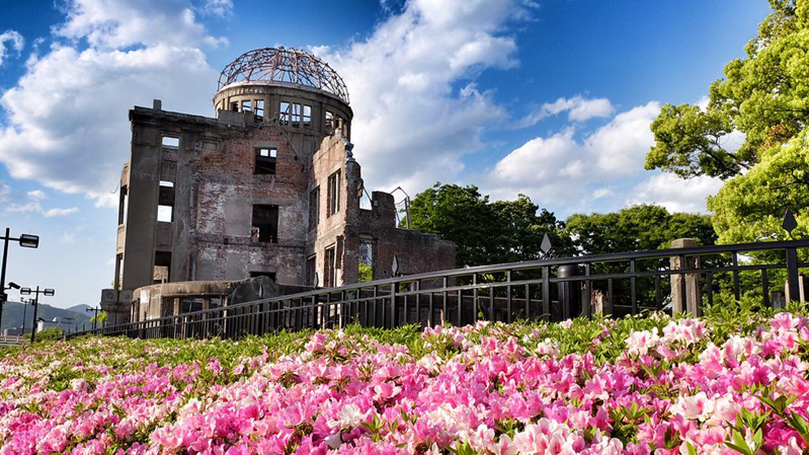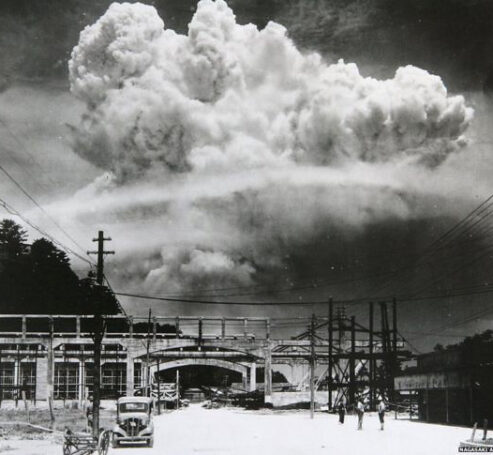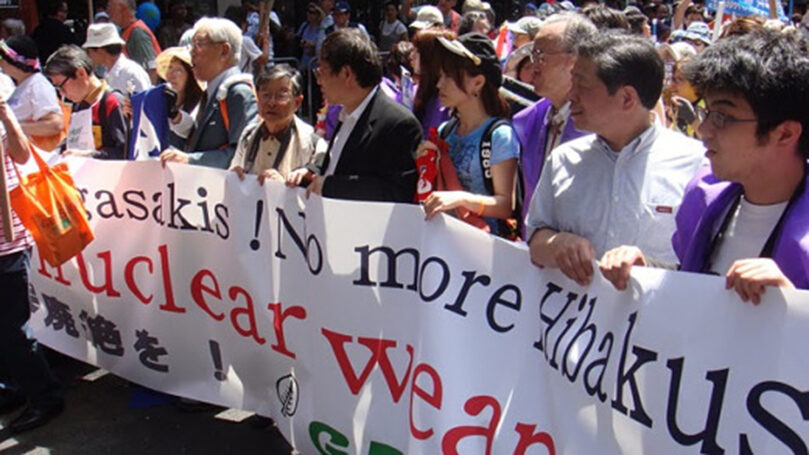
Arguably the first step in half a century to eliminate nuclear weapons, the Treaty for the Prohibition of Nuclear Weapons (TPNW) makes it internationally illegal to “develop, test, produce, manufacture, otherwise acquire, possess, or stockpile nuclear weapons or other nuclear explosive devices.”
At the United Nations in 2017, 122 countries, none of them possessing nuclear weapons, negotiated and voted for the TPNW, which required 50 nations to ratify it before becoming law. On October 24, 2020, Honduras became the 50th country to ratify the historic nuclear weapons–ban treaty. The Treaty goes into force on January 22, 2021.
Abolishing nuclear weapons has been a goal for much of the human race since the United States first disclosed them by incinerating two cities in Japan at the end of World War II in 1945.
On two days in August 75 years ago, nearly a quarter of a million Japanese were vaporized instantly or died horribly within hours or days after the U.S. exploded atomic bombs in the midst of Hiroshima and Nagasaki. The scale of such quickfire mass slaughter by nuclear war is hard to comprehend.
 The U.S.’s atomic bombing of Hiroshima and Nagasaki, even as Japan was essentially defenseless, defeated, and desperate, aimed to keep the Red Army from overrunning and occupying Japan. It was a warning to the USSR and all other nations that the U.S. planned to rule the world.
The U.S.’s atomic bombing of Hiroshima and Nagasaki, even as Japan was essentially defenseless, defeated, and desperate, aimed to keep the Red Army from overrunning and occupying Japan. It was a warning to the USSR and all other nations that the U.S. planned to rule the world.
In 1946, as the hope for peace by means of the United Nations was being established, the Soviet Union’s Joseph Stalin proposed that nuclear weapons be handed over to that body. U.S. President Harry Truman refused.
Since then, the U.S. government steadily led the nuclear arms race, exponentially increasing the bombs’ destructive power and portability while amassing, deploying, and stockpiling a huge arsenal threatening widespread death.
But the U.S. was unable to keep its monopoly on nuclear weapons. Since 1949 nine other countries have obtained these civilization killers — the Soviet Union (now Russia), Britain, France, China, Israel, India, Pakistan, the Democratic People’s Republic of Korea, and South Africa, which relinquished them in the early 1990s. As the nuclear weapons club grew, so did the risk that these weapons would be used.
Since 1945 the U.S. ruling class has considered nuclear weapons as its final solution to the challenges of socialism and national liberation that resist the demands and rule of monopoly capitalism. The U.S. has threatened to drop nuclear explosives on countries whose governments it tried to overthrow, North Korea and Vietnam among them, and has consistently resisted attempts at controlling and even eliminating these devices of mass slaughter.
In a “small” nuclear exchange with today’s modern thermonuclear weapons, the numbers of instantaneous deaths by incineration would be in the tens of millions, with hundreds of millions more soon to die of sustained burns, wounds, and radiation poisoning and even more survivors dying of starvation from nuclear clouds over much of the planet preventing growth of food crops.
The Bulletin of the Atomic Scientists’ Doomsday Clock has been set at 100 seconds to midnight, based on the likelihood of either nuclear war or climate catastrophe, two human-caused innovations that threaten to extinguish the human race along with untold species of plants and other animals.
Under President Barack Obama and continued under President Donald Trump, the U.S. initiated a new nuclear arms race that will cost U.S. society $1.7 trillion, underwriting a policy that will profit the military industries; draw thousands of skilled workers, scientists, and engineers into the merchandising of death; and further militarize our nation and the world.
At the same time, spending that treasure on renewing the nuclear existential threat starves our people of resources desperately needed for health care, food security, affordable housing, education, infrastructure repair, and the Green New Deal. It is another means of waging endless war.
To date, the overall global effort to eliminate nuclear weapons has failed, but there have been some successes in minimizing their numbers and preventing the technology from spreading beyond the existing weapons states. The nations of the world negotiated and put into force the nuclear Non-Proliferation Treaty (NPT) in 1970 to limit spread, promote disarmament, and encourage peaceful use of nuclear energy.
The NPT limited nuclear weapons to the then existing possessors — the U.S., USSR, Britain, France, and the People’s Republic of China. Subsequently, three states — India, Pakistan, and Israel — that didn’t sign the treaty developed their own weapons, and the DPR Korea, which had signed the treaty, backed out to build its own bombs.
Significantly, Article 6 of the NPT, which requires nuclear weapons states to disarm, has been blatantly ignored. And until this year nuclear weapons have not been legally banned.

There have been numerous other attempts to reduce the nuclear weapons threat, and many of the agreements have unilaterally been cancelled by the United States:
The Partial Nuclear Test Ban Treaty of 1963 resulted from public anxiety over nuclear fallout and limited nuclear tests to underground.
The Anti-Ballistic Missile Treaty (1972). The ABM Treaty aimed to prevent a first-strike nuclear attack by a nation that had means to shoot down incoming retaliatory missiles to protect itself. George W. Bush scrapped it in 2002 as the U.S. pursued first-strike dominance.
The Intermediate-Range Nuclear Forces Treaty (1988). Ronald Reagan was forced to negotiate and sign the INF Treaty banning intermediate range ballistic missiles in Europe and the western Soviet Union because of massive public pressure both in Europe and the U.S. Donald Trump scrapped this treaty and, following the policies of his predecessor, has been moving NATO forces, including missiles, up to the western border of Russia.
The Comprehensive Nuclear-Test-Ban Treaty (1996). The U.S. never ratified this, and thus it has not come into force. However, aside from DPR Korea, the nuclear weapons states have since avoided testing nuclear weapons, although the U.S. carries out tests of systems, stopping just short of exploding them.
Strategic Arms Reduction Treaty (1994). START I was the first treaty to limit the deployment of nuclear warheads and to reduce the numbers the U.S. and Russia maintained. Jointly these two countries hold by far the biggest arsenals. The treaty is up for renewal in February 2021, but the Trump administration has decided to let it die. What a President Biden will do is uncertain.
The Open Skies Treaty (2002) allowed unarmed surveillance flights over member countries to collect information about military activities and build international security. President Trump killed this treaty on November 22, 2020.
Joint Comprehensive Plan of Action (2015). The JCPOA is a multi-lateral treaty that specifically prevents Iran from developing nuclear weaponry. President Trump unilaterally withdrew the U.S. from this treaty in 2018 and reimposed deadly sanctions on Iran.
It is important to note that there are numerous regional treaties that create nuclear-weapons-free zones, for example in Latin America and the Caribbean, the South Pacific, and Africa.
After the failure of numerous other efforts to remove nuclear weapons from the face of the earth, the Nuclear Ban Treaty was conceived by the International Campaign to Abolish Nuclear Weapons (ICAN), with support organized and promoted by over 400 partner organizations in 103 countries.
From its inception and promotion in the United Nations, the nine nuclear-weapons states opposed this treaty and boycotted negotiations. Opposition to the treaty came as well from five U.S. allies in NATO that stockpile U.S. weapons — Belgium, Holland, Germany, Turkey, and France.
Moreover, the Trump administration has been twisting the arms of ratifying countries to retract their ratification.
While the Ban Treaty applies only to those countries that have ratified the treaty, it is still truly historic.
Based on earlier experience with treaties banning chemical and anti-personnel weapons and land mines, the Ban Treaty can create a norm that pressures the nuclear-weapons states to change their actions. For example, now that nuclear weapons are prohibited by international law, anti-nuclear activists have another political tool to pressure financial institutions and pension funds, among others, to divest from companies that make nuclear weapons and delivery vehicles.
As pressure increases from non-nuclear-weapons states to abolish the bombs, those of us living under governments threatening catastrophic war have increased responsibility to force them to join this new treaty and eliminate one of the gravest dangers to civilization.
Images: Top, Hiroshima dome, Antonello (CC BY-NC-SA 2.0); Nagasaki bombing, bswise (CC BY 2.0); Anti-nuke march, New York, 2010, People’s World.


 Join Now
Join Now